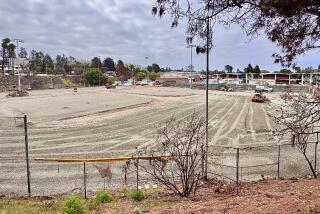School’s al Fresco Dining Ordeal Eases
- Share via
Stormy weather doesn’t make cafeteria manager Linda Dinkins worry about her students the way she once did.
The children of Russell Elementary School now eat lunch inside warm bungalows on cold mornings and rainy days. Cafeteria workers prepare meals in a portable kitchen on campus instead of hauling food via golf cart from the kitchen of a nearby middle school.
At this South Los Angeles school, which has been without a cafeteria or auditorium since an arson fire in 1998, the new portable kitchen and bungalows have made lunch on rainy days--and every day--an easier affair.
“It’s a step up,” Dinkins said. “Before, it was ‘Lord, please don’t let it rain.’ Now, it can rain. . . . We don’t have to worry about going back and forth. We don’t have to worry about what’s going to happen” with the weather.
The fate of the school’s cafeteria and auditorium, however, is still clouded in uncertainty. Since the fire, parents and staff have watched as delay after delay slowed the repair work.
Construction, which had slogged along before, has ended completely, ordered stopped by district officials in December.
Problems With Contractor Alleged
“We’ve suspended work on the buildings at the moment because the contractor wasn’t progressing as he should,” said Paul Holmes, the school district’s director of modernization-existing facilities, adding that “112% of the time had elapsed and only 9% of the work had been done.”
District officials are preparing to hold hearings to determine if the contractor has defaulted on the contract. The proceedings might ultimately enable the district to remove the contractor and hire another one.
The contractor disputes the district’s version of events and has hired an attorney.
“In my opinion the district is completely in error,” said Joseph Juge, of Juge Co. “At this point they have not identified why they are defaulting me. I have requested that information in writing twice and to date I still have not been told the reasons.”
The proceedings are the latest development in the buildings’ long journey toward restoration. That journey has been fraught with delays, some as unavoidable and unpredictable as the weather, some completely man-made.
Officials predicted last October that the project would be finished by this spring.
Some staff and parents at the school said the buildings’ continued state of disrepair is symbolic of the unfair treatment schools in poorer communities receive. Since the fire, staff and students have gone without the basics: a cafeteria, an auditorium for large assemblies and a teachers’ lunchroom. The situation would not be tolerated, some argued, if the school was in a wealthier community.
In the absence of a cafeteria, workers were forced to operate under a system that relied on a golf cart and the availability of ovens at a nearby school.
Each day the district sent prepared meals from its nutrition center near downtown. Those meals were stored at Drew Middle School.
Before each meal, a cafeteria worker hopped on a golf cart and rode across a field separating the schools to the kitchen, where she warmed the meals. The worker then reloaded the meals into the cart and headed back to the elementary school, where the meals were distributed to students lined up in front of lunch tables that served as a makeshift counter. They sat outside at benches.
In November, the district sent the trailers and portable kitchen to the campus.
“The decision was made because we found out the kids were being fed their lunches in a manner we didn’t agree with,” Holmes said.
Official Says He Was Unaware of Problem
Holmes said he had been unaware of conditions at the site. The bungalows that serve as lunchrooms cost the district $12,414 for the first six months, then $500 to $600 each subsequent month, Holmes said.
The portable kitchen is owned by the district. The only cost incurred is for utilities and construction of a $2,300 ramp.
“This is a kitchen the district owns for such emergencies,” Holmes said. “Don’t ask me why it wasn’t brought out earlier. I wasn’t here.”
Students still eat in shifts, but with the bungalows they have options. They eat outside when the weather is nice, but on cold mornings and rainy days students can eat inside “and take their jackets off,” Dinkins said.
The bungalows are 24 by 40 feet and inside are long lunch tables. The school is making the most of the space. During the Christmas season, there was a tree in the lunchroom. The room is also used for tutoring Spanish-speaking parents in English.
A community meeting will be held tonight to answer questions. It will be the first meeting since the district embarked on default proceedings, said Al Bowen, facilities director for District 1, which includes Russell.
Neither the contractor nor district officials would talk about the specifics of the dispute, beyond the issue of time.
On Jan. 25 the district’s facilities committee will hear from Holmes’ staff and from the contractor. The case may then be presented to the full Board of Education in February. Board members will determine whether the contractor defaulted on the contract.
If he is found to be in default, “he will be replaced with a contractor who will do the work,” Holmes said, adding that after a new contractor is found, the work will be completed in five months.
The staff has worked hard to minimize the effect of the delays on students and that job, at least, has gotten a little easier.
“They have to do what they have to do,” Dinkins said of the most recent delays. “But we’re happier now. The first time it rained was last week, and it was OK.”
More to Read
Sign up for Essential California
The most important California stories and recommendations in your inbox every morning.
You may occasionally receive promotional content from the Los Angeles Times.













